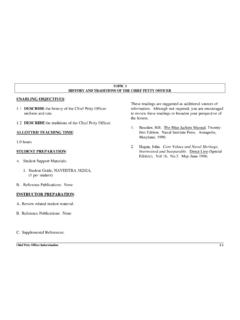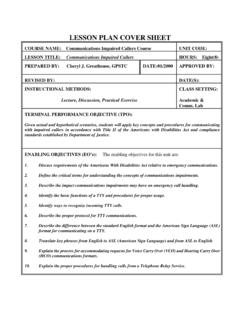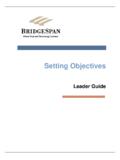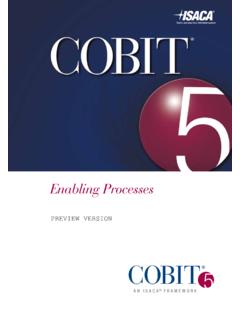Transcription of FEDERAL GOVERNMENT DISTANCE LEARNING …
1 A QUICK REFERENCE GUIDE TO DEVELOPING COGNITIVE LEARNING objectives Jolly T. Holden, 2009 FEDERAL GOVERNMENT DISTANCE LEARNING association 2 Copyright 2009 by the author, Dr. Jolly Holden. All Rights Reserved. This publication may be downloaded, printed, and distributed for personal use and may be freely printed and distributed providing its use is strictly non-commercial and for educational purposes. Users are forbidden to reproduce, republish, or redistribute with the intent to resell or profit from this publication in either machine-readable form or any other form without permission of the author. 3 Table of Contents Introduction.
2 4 Classification of LEARNING objectives .. 4 General or Overall Objective .. 4 Specific Objective .. 4 Difference Between an Instructional Goal and a Terminal 5 Difference Between a Terminal Objective and an Enabling Objective .. 5 Taxonomy of Educational objectives .. 5 Cognitive Domain .. 6 Affective Domain .. 6 Psychomotor Domain .. 6 LEARNING objectives Based on the Cognitive Domain .. 6 The Condition .. 6 The Behavior .. 7 The Degree .. 7 Continuum of Cognitive Domain objectives .. 7 Examples of Cognitive LEARNING objectives .. 8 Bloom s Revised Taxonomy .. 8 Table 1: The Cognitive Domain of objectives .. 10 Table 2: Definitions of Behavioral Verbs for LEARNING objectives .
3 11 Table 3: Assessing LEARNING objectives Using Bloom s Taxonomy .. 13 Reference List .. 15 4 Introduction A LEARNING module/course is designed as a response to education and/or training needs, and the degree of precision of articulating the LEARNING objectives is directly related to achieving the desired LEARNING outcomes. Since LEARNING objectives are developed from a knowledge/skill gap analysis identified in the front-end needs assessment process, the goal of creating LEARNING objectives is to ensure the training/education and/or intervention is successful and the objectives are achieved. Clearly identifying LEARNING objectives improves the communication between the instructor and the learner for a given course/ LEARNING module so the student knows precisely what is expected of him/her.
4 When the objectives of a course have been clearly identified and presented in an orderly progression, the desired LEARNING outcomes will be attained. They may also assist in the choice of the instructional delivery method(s) and instructional strategies when designing a LEARNING activity, as well as establishing criteria for student performance when assessing student LEARNING outcomes (Dick, Carey, & Carey, 2005). When clearly defined objectives are lacking, there is no sound basis for the selection or designing of instructional materials, instructional strategies, or assessments (Mager,1999) . A properly written objective tells you what specific knowledge, skill, or attitude is desired and what method of instruction and criteria for learner achievement are required (Lohr, , pp 7).
5 A LEARNING objective (also referred to as instructional objective or performance objective) is a succinct statement that describes the specific LEARNING activity and includes a description of a performance you want learners to be able to exhibit in order to evaluate competency. It is expressed in terms of the student and formulated in terms of observable behavior and the special conditions in which the behavior is manifested. An instructional objective describes an intended outcome of instruction rather than an instructional procedure (Mager, 1999). Classification of LEARNING objectives LEARNING objectives can be categorized as either general or specific.
6 General or Overall Objective The general objective defines the outcome of the instructional unit and represents the general orien-tation of a course, lesson, or training intervention. The general objective is the first level of specifi-cation of the unit of instruction and states what the student should be able to at the end of the unit of study. General objectives are commonly referred to as Terminal Course objectives (TCO), Ter-minal LEARNING objectives , or simply Terminal objectives . Each terminal objective is analyzed and broken down into smaller objectives that measure an element of the terminal objective. Terminal objectives represent performance at the task level and are normally derived from a task and/or per-formance/knowledge gap analysis.
7 Specific Objective Specific objectives are statements of the knowledge, attitudes, and skills that support a terminal ob-jective. Often referred to as enabling objectives , performance objectives , instructional objectives , or behavioral objectives , an ..objective is a detailed description of what students will be able to do when they complete a unit of instruction (Dick et al., 2005. pp 125). The specific objective is the second level of specification of the lesson and must be developed for each of the tasks selected in the LEARNING program (Mager, 1975). While these objectives are derived from the terminal objective, 5 they are more specific and expressed in terms of the student and formulated in terms of observable behavior and the special conditions in which the behavior is manifested.
8 The following general rules should prove useful in writing specific instructional objectives : Be Concise. An instructional objective is a specific statement of what the learners will be able to do when they complete the instruction (Dick et al, 2005) Be Singular. Should focus on one aspect of behavior Be Realistic. An instructional objective should focus on observable/measurable behavior, not on teacher illusions or indefinable traits. Difference Between an Instructional Goal and a Terminal Objective An instructional goal is a general statement of the intended outcome or overall purpose of an in-structional unit or course and may not be easily measurable.
9 An instructional goal represents the big picture view and in broad terms specifies what is expected of the student at the end of the LEARNING activity. While an instructional goal statement describes a more global LEARNING outcome, a LEARNING objective is a statement of specific performances which contributes to the attainment of the goal. When the instructional goal is converted to a performance objective, it is referred to as the terminal objective (Dick, , 2005, pp 125) and for every unit of instruction that has a goal, there is a terminal objective (pp 131). Note: The term LEARNING outcomes are often used interchan-geably with instructional goals in that they represent a broad performance statement which incorpo-rates a wide range of knowledge, while objectives describe performance based on discrete and mea-surable behavior that focus on specific units of knowledge (What's the Difference Between Learn-ing Outcomes and LEARNING objectives , ).
10 Difference Between a Terminal Objective and an Enabling Objective Terminal objectives describe, in broad terms, what the learner s expected level of performance, competency, or knowledge must be at the end of a course, module, or lesson. Enabling objectives are derived from the terminal objective and are more detailed by defining the specific performance and/or knowledge of the learner. Enabling objectives define specific, measurable outcomes that must be mastered in order to satisfy the terminal objective. In a well designed unit of instruction, instructional goals, terminal objectives and enabling objectives are clearly stated and logically linked in a top-down fashion.




